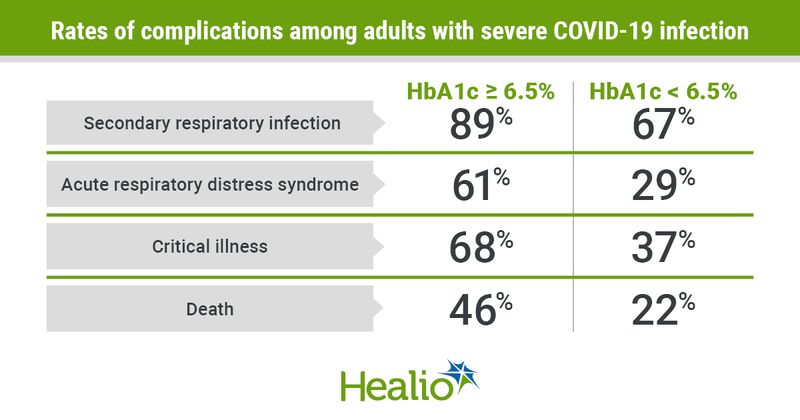High HbA1c increases risks for acute respiratory distress syndrome, COVID-19 mortality
Adults with COVID-19 admitted to two ICUs in China were at greater risk for secondary respiratory infections, acute respiratory distress syndrome and mortality with an HbA1c of 6.5% or higher, according to study data.
“For the first time, we explored the effects of blood glucose on complications, severity and mortality rate of COVID-19 patients from the perspective of HbA1c, which reflects the long-term glycemic control degree before admission,” Benping Zhang, MD, PhD, department of endocrinology at Tongji Hospital in Wuhan, China, and colleagues wrote in a study published in the Journal of Diabetes Investigation. “Patients with HbA1c of 6.5% or more were more likely to develop secondary respiratory infections and acute respiratory distress syndrome than patients with HbA1c less than 6.5%, resulting in a higher proportion of critically ill cases and nonsurvivors. After adjustment for potential risk factors, HbA1c was independently associated with in-hospital death.”

Researchers conducted a retrospective study of 77 adults (mean age, 63.6 years; 62% men) admitted to two ICUs within the Sino-French Branch of Tongji Hospital. All participants were classified as severely ill (n = 40) or critically ill (n = 37) at admission and were either discharged or died in the hospital in February. Researchers divided patients into those with HbA1c of less than 6.5% (n = 49) and those with HbA1c of 6.5% or more (n = 28). Five individuals in the lower HbA1c group and all participants in the higher HbA1c group had diabetes. Demographics, comorbidities, COVID-19 symptoms and signs, laboratory measurements and clinical outcome data were collected through electronic medical records.
Patients with HbA1c of 6.5% or higher had a higher heart rate (101 beats per minute vs. 89; P = .012) and lower percutaneous oxygen saturation (93% vs. 97%; P = .001) than those with lower HbA1c. The higher HbA1c cohort also had a higher white blood cell count, neutrophil count, high sensitivity C-reaction protein, serum ferritin (P < .05 for all), and a lower lymphocyte count (P = .049) compared with participants with lower HbA1c.
Individuals with a higher HbA1c were more likely to develop secondary respiratory infection (89% vs. 67%; P = .032) and acute respiratory distress syndrome (61% vs. 29%; P = .006) than those with lower HbA1c. In the higher HbA1c group, there were also higher rates of critical illness (68% vs. 37%; P = .009) and mortality (46% vs. 22%; P = .029) than the lower HbA1c cohort. Univariate analysis showed HbA1c was associated with an increased risk for in-hospital death (HR = 1.3; 95% CI, 1.044-1.617, P = .019). The risk remained higher in multiple models adjusting for age, sex, comorbidities and laboratory results.
“The incidence of critically ill cases and mortality rate were significantly higher in the insufficient glycemic control group, and HbA1c was a significant independent risk factor associated with in-hospital death of patients with COVID-19,” researchers wrote. “Severe pulmonary infection and consequent acute respiratory distress syndrome, but not extrapulmonary organ injuries, might be the primary cause of death in patients with insufficient glycemic control. Routine examination of HbA1c, and timely identification and treatment of pulmonary secondary respiratory infections and acute respiratory distress syndrome might be beneficial to improve the prognosis of COVID-19 patients with insufficient glycemic control.”

